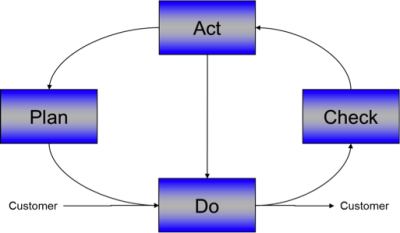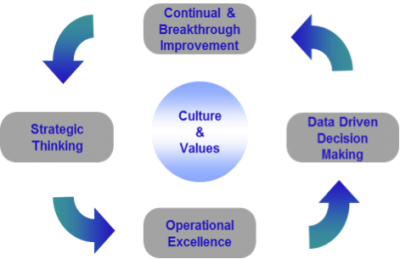It’s a competitive world
Every morning a Gazelle wakes up in Africa. It knows it must run faster than the lion or it will be eaten. Every morning a lion wakes up. It knows it must outrun the gazelle or it will starve. It doesn’t matter whether you are a lion or a gazelle, when the sun comes up, you had better be running. Globalisation, more competition, increasing customer demands, whatever the challenges faced the need to improve has never been greater.

It is a competitive world. Both Lean and Six Sigma originated because of a need to improve to become more competitive. Lean originated with Taichi Ohno in Toyota, Toyota’s need was to be able to compete with the American automobile industry, which was dominating globally in the 1950’s using volume production. The Japanese strategy was to compete by offering different models with different options, but this required a change in manufacturing capability, to be able to produce faster, with lower stock and higher variety.
Motorola sold a TV business to Matsushita because they could not get product quality consistent. The company was losing market share in many key segments, including televisions, car radios and semiconductors. Motorola's President and CEO Bob Galvin decided to launch a global improvement initiative, focusing on improving consistency and customer satisfaction to ensure that Motorola reclaimed their position as a global leader in electronic products.
Processes

All organisations operate processes that transform inputs into outputs. These processes are used to provided services or goods. Any process can be considered to have two dimensions of performance, how effective the process is in meeting its objectives (for example quality of output supplied, whether it is supplied when agreed), and efficiency (the resources consumed by the process, for example people, equipment, utilities).
The resources consumed will vary depending on the process involved. Resources consumed include the following:
- People
- Equipment
- Utilities
- Space
Most resources cost money. An efficient process will consume the minimum amount of resources required to transform inputs to outputs and therefore be cost efficient. An efficient process can also be said to have no waste.
An effective process will satisfy the customer of the process. Customers will judge the quality or adherence to requirements of the product, and whether it was delivered in the agreed time. The customer will also judge the price they pay.
If the customer judges that the value they receive from the quality/delivery/price combination is satisfactory, and the process is operating efficiently and able to produce at a lower price than the customer pays, then there is a sustainable system. If the customer judges that the value is not satisfactory, or the manufacturing operation is not able to produce efficiently and the cost is higher than the price, then the system is not sustainable.
Improvement

Improving organisation performance involves either becoming more efficient, becoming more effective, or both. The principles of the Lean approach, developed from the Toyota production system, are to identify and eliminate waste in business processes to make them more efficient. The principles of Six Sigma, made famous by Motorola and GE, are to develop processes that are more effective for both the business and the customer by identifying and controlling the factors that impact on process variability. Although the two have different objectives, in reality there is a significant overlap as when a process is made more effective, often the efficiency improves, and when waste in a process is reduced, invariably the process becomes more effective. In making processes more effective, waste is eliminated, and the customer determines what adds value and hence what is waste. The third possibility to improve organisation performance is of course to develop new products or processes.
These three components (become more efficient, becoming more effective, developing new products and processes) can be considered as the three dimensions of improving the organisation.
The combination of Lean and Six Sigma approaches to tackle these improvement areas has become known as Lean Six Sigma. Lean Six Sigma has become a systematic approach to identifying and improving important business processes so that they operate efficiently and effectively to achieve customer satisfaction and the organisation’s business goals, and developing new products and processes that operate right first time.

There have been many approaches to organisation improvement over the years, including TQM (Total Quality Management), BPR (Business Process e-engineering), Ci (Continuous Improvement). All these approaches have 2 things in common:
1. The application of scientific tools and methods to business problems
2. A desire to change the “culture” of the organisation so that everyone becomes involved in improvement effort and it becomes a routine activity.
Linking to Strategy
The weakness of many of these previous approaches was their lack of focus on the important issues that existed within the organisation, for example suggestions schemes developed a bad reputation because they would highlight such things as the need for a new coffee machine in the canteen. Whilst no-one would argue that installing a new coffee machine was of no relevance to improving an organisation, in most organisations it would not be the most crucial thing to do.

The Lean Six Sigmaapproach provides a focus on improving the most important things first. To illustrate this, consider the PDCA framework made famous by Deming. This is how it applies in terms of business operation. The “Do” part of the framework is the Operations, which is focused on understanding and satisfying customer requirements with suitable products and services.
The “Plan” part of the framework is concerned with developing strategy and business goals, which are then implemented into the organisations operations, most organisations will have as a minimum some short term objectives, sales values and so on. The Check part of the framework relates to assessing performance against the goals, typically using such things as KPI’s (Key Performance Indicators). If everything is on track, then of course no further action is required, and things just carry on! If there are “gaps” between the planned goals and the actual performance then some action is necessary to improve things. These gaps can be called Strategic Gaps. So, action to improve the organisation should be focused on the largest strategic gaps.
Once these gaps have been identified, then projects are set up to close them. The projects are run using specific methodologies, DMAIC (Define, measure, anlayse, improve, control) and DMADV (Define, Measure, Analyse, Design, Validate), by trained practitioners (Green, Black, and Master Black Belts) using well proven toolsets.
Fundamentally Lean Six Sigma is a system to address strategic gaps, by improving the efficiency and effectiveness of existing processes, and developing new products, processes and services, using defined methodologies and tools. It stands to reason, that the larger the strategic gaps, the better results can be achieved through the application of Lean Six Sigma methods. Or, to put it another way, the more screwed up an organisation is to start with the better the Return on Investment for the improvement activity!
Sustainable Improvement
However, this is not the end of the story. If we examine the Motorola story, the GE story, the Toyota story or many others that have achieved success using Lean and Six Sigma methods it becomes clear that the methods and tools alone are not the reason for the success of these initiatives. In each case there has been a strong leader, who had an unshakeable belief in the direction the organisation needed to go, and the need for excellence, continuous and never ending improvement.

At Sigma we have studied many organisations that have achieved success, and identified four organisational competences that are required to achieve a sustainable approach to business improvement. These are Strategic Thinking, Operational Excellence, Data Driven Decision Making and Continual & Breakthrough Improvement. Supported by the right kind of culture, value and leadership, an organisation can achieve sustainable improvement.
The other part of our research has established that organisations don’t change overnight to suddenly become a six Sigma or lean company. Most will progress through stages of maturity, developing their approaches to organisation improvement as they go. Even looking back to Motorola and Toyota it is clear that their improvement approaches were developed over years, even decades. Learning from them means that today’s organisations can progress much quicker, but each organisation is different and needs to develop its own approaches to fit the culture as it changes.
The Sigma research has highlighted three phases that organisations go through on their improvement journey before they reach maturity, these being establishing sound foundations, building for future success and putting in place the final blocks required to ensure sustainability.

It’s a bit like building a house, first the foundations, then the walls, then finally the roof. Once these are in place and the building is watertight, you can continue to work on the inside, start inside before these things are done and you’re wasting your time!